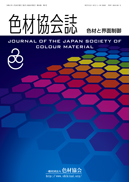
- |<
- <
- 1
- >
- >|
-
Yoko AKIYAMA2020 Volume 93 Issue 2 Pages 37-41
Published: January 20, 2020
Released on J-STAGE: March 05, 2020
JOURNAL RESTRICTED ACCESSTactile sensations caused by active touch are closely related to interfacial interactions such as friction, wetting and adhesion. This article outlines the characteristics of tactile sensations, and then introduces some examples of the relationship between interfacial intaraction and tactile sensation. Finally, the relationship between the confortness and interfacial interaction is discussed.
View full abstractDownload PDF (811K)
-
Kazuyoshi KAWAMI, Mutsuharu IMAOKA, Shingo HIROSE2020 Volume 93 Issue 2 Pages 42-48
Published: January 20, 2020
Released on J-STAGE: March 05, 2020
JOURNAL FREE ACCESSThe uneven coloring arising from the use of an INCO color development method is considered to be due to the inhomogeneity of the surface oxide film caused by scars from stainless steel processing.
We checked the state of the surface oxidation layer with a color development treated stainless steel board after electrolysis abrasive polishing. It is important to know the state of the film as this provides guidance on how to reduce the unevenness of the colouring. In the present case we used an electron microscope and performed an inspection of the film structure.
View full abstractDownload PDF (2673K)
-
Kenta TANAKA, Yujiro HOSHINO, Kiyoshi HONDA2020 Volume 93 Issue 2 Pages 49-53
Published: January 20, 2020
Released on J-STAGE: March 05, 2020
JOURNAL RESTRICTED ACCESSOrganic dyes are one of attractive synthetic targets for material and biological fields in organic chemistry. Recently, organic dyes have been developed to be used as an efficient photosensitizer in photoredox catalysis, which can be applied to various types of photoredox reactions. Despite the promising properties of recently reported catalysts, these normally suffer from narrow absorption windows and the requirement of high-energy light sources (UV or blue light). Green light, on the other hand, is of lower energy (500~570 nm) than UV and blue light, which efficiently reduces energy costs and the risk of substrate/product damage and stress. In this account, our recent research on the design and synthesis of strongly oxidizing methoxy-functionalized thioxanthylium organic dyes, which absorb 400~600 nm in visible light region, is described. They can be applied to the photoredox reactions such as radical cation Diels-Alder reaction and oxa-[4+2] cycloaddition reactions under green light irradiation. The present catalysts provide a new green-light-driven photoredox catalytic system.
View full abstractDownload PDF (877K)
-
Takayuki DOI, Minoru INABA2020 Volume 93 Issue 2 Pages 54-58
Published: January 20, 2020
Released on J-STAGE: March 05, 2020
JOURNAL RESTRICTED ACCESSThere is a strong demand to further improve the energy density, rapid charging performance, long cycle performance and high safety of lithium-ion batteries for EV application. A further improvement in performance of electrolyte solutions, including lithium ion conductivity and high stability against oxidation and reduction, is required to fully elicit the electrode performance. Highly concentrated electrolyte solutions have been recently reported to offer multiple unique features. However, they are highly viscous and very costly due to an extensive use of lithium salts. These problems can be solved by diluting the highly concentrated electrolyte solutions with an appropriate diluent. There are still lots of things to be learned from a dilution technique for pigment dispersion.
View full abstractDownload PDF (814K)
- |<
- <
- 1
- >
- >|